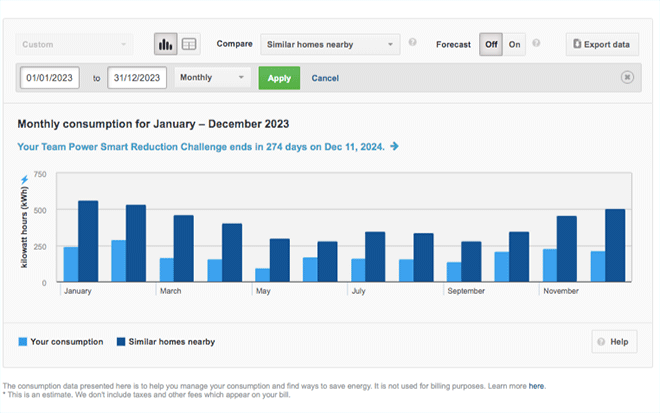Many moves are free or low-cost, while others can result in significant savings over the next few years.
When it comes to energy conservation at home, what are your best options? You may just want to ensure home comfort while shaving a little off your bills. Maybe you want to reduce seasonal bill increases. Or you may want to make a major change, perhaps as part of a home renovation project, that will completely overhaul your home’s energy use.
Before you get started, take a look at your daily and seasonal energy use. To see if your energy use is above average for your home’s size, use the “Compare to similar homes nearby” filter.
After a few minutes of looking at your home’s energy use, you should have a better idea of when and where you can save energy. You can look at energy use on laundry days, when it’s really cold or hot outside, and days when you’re not home.
Low-hanging fruit: Free ways to save energy and money
Shorten your showers: If you use a standard shower head and reduce the average shower time of two people in your home by two minutes per person, you could save $60 on your water heating bill over the course of a year.
Wear sweaters and slippers: Especially when you’re not active in your home, like when you’re on your laptop or watching TV, putting on a sweater or hoodie and slippers (or even a blanket on the couch) can allow you to lower the temperature and save money.
Adjust your thermostat: Unless you’re using a heat pump (which is most effective when you set it and forget it), program your thermostat or set it manually to keep the temperature lower at night or when you’re not home.
Cook with small appliances: If you have them, slow cookers, air fryers, ovens, and pressure cookers can save you time, energy, and money.
Use curtains wisely: On cold days, open the blinds as soon as the sun starts to shine through the windows. On hot days, close the curtains on the south and west sides of the house to block out the sun.
Wash clothes in cold water: Just select the cold water wash option on your washing machine and make sure to use a detergent formulated for cold water washing. About 80% of the energy used by a washing machine is used to heat the water. Washing full loads of laundry and choosing high speed or extended spin to remove as much water as possible will reduce your drying time and energy usage.
Use your dryer efficiently and consider hang drying: A dryer uses more energy per use than any other appliance in your home, so use it efficiently and sparingly to help reduce your energy costs.
Once warmer weather arrives, double check that the heating is off in all rooms: This is an easy mistake to make. Come July, you walk into a room you rarely use and find the baseboard heating is still on.
Low-cost, do-it-yourself fixes and upgrades
Replace inefficient lights: LED (light-emitting diode) bulbs are no longer an experiment. Don’t wait until inefficient incandescent bulbs expire before replacing them. By replacing incandescent bulbs with LEDs, you can save $75 on your electricity bill over the life of the LED bulb, which has a lifespan of 10 to 15 years.
Fix leaky taps: Leaky taps can waste up to 11,350 litres of water per year. Fix a leaky hot water faucet and save up to $33 per year on your hot water bill
Install a faucet aerator and/or low-flow showerhead: Installing a high-efficiency aerator over your kitchen sink can save you $28 per year on your hot water bill. The payback for installing a low-flow showerhead (which costs as little as $15) is almost immediate, depending on how often you shower.
Storm-proof windows and doors: When your building is drafty, your heating and cooling systems have to work harder. Storm windows (also called draft stripping) are one of the easiest and most affordable ways to improve your home’s energy efficiency.
Bigger projects that really pay off
Upgrade insulation: With new insulation and some DIY draft-proofing, you can save about 10% on your heating and cooling bills, which can add up to more than $200 per year. Strengthening the building envelope is your best defense against outdoor air in both winter and summer. It’s also a smart step before switching to a heat pump, which should be sized based on your home’s energy needs.Get rebates up to $5,500 for insulation in attics, basements and crawl spaces, exterior wall cavities, and more.
Switch to an electric heat pump: Heat pumps efficiently heat and cool your home, keeping it comfortable year-round. If you switch from fossil fuel heating to an electric heat pump, it also reduces greenhouse gas emissions.
Buy an electric car: No, your home electric bill won’t go down when you charge your electric car at home. But you’ll save a ton on fuel costs—it’s much cheaper to power a car with electricity than with gasoline—and on vehicle maintenance costs.

